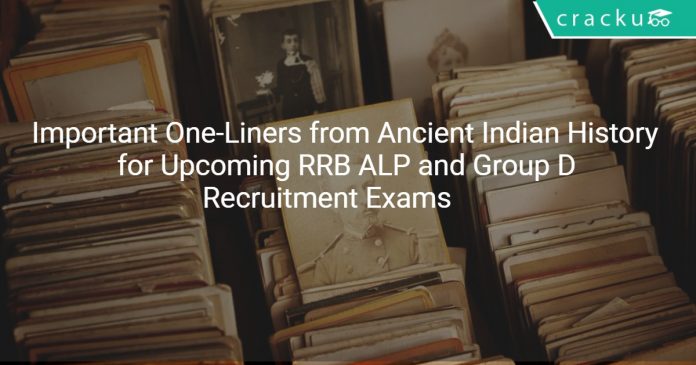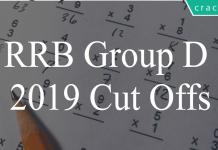Ancient Indian history PDF Notes for Competitive exams:
This is an ancient Indian history notes for UPSC, SSC CGL, SSC CHSL, Railways RRB ALP, RRB Group-D exams.
Download Ancient History for Railways Pdf
20 RRB NTPC Mocks for Rs. 149 – Enroll here
Download Medieval Indian History PDF
Download Modern Indian History Notes PDF
Important One-Liners from Ancient Indian History :
- Archaeology is the study of Human activity through the recovery and analysis of Material Culture.
- Ancient India as suggested by many historians extends over a period from Pre Histoic Time to around 750 A.D – the end of Gupta Empire.
- The first known metal used by man is“Copper”
- “Bhimbetka Rock Shelters”is an archaeological site of the Central India which is believed to have Originated in the Paleolithic and Mesolithic Periods is considered as one of the UNESCO World Heritage Sites.
- Two Important Cities of the time of Indus Valley Civilization are Mohenjo-daro and Harappa
- Study of Coins is called Numismatics
- The study and Interpretation of Ancient Inscriptions is called Epigraphy
- Arthashastrais an ancient Indian literature on Statecraft, Economic Policy and Military Strategy written in Sanskrit by Kautilya – also known as Chanakya during the period 350 – 275 BC
- Kautilya- Chankya was the Chief Advisor and Prime Minister to the Indian Emperor Chandragupta who is the founder ruler of Mauryan Empire in 350 BC
- Kalidasa is often referred to as the Shakespeare of India belonged to the period of Gupta Empire
- Notable Work of Kalidasa are Abhijnanasakuntalam
- Buddhism is born in 563 BC at Lumbini, Nepal
- Founder of Buddism – Siddhartha Gautama Buddha
- Buddha – Siddhartha Gautama attained “Nirvana” in Gaya – Magadha( Bihar) at the age of 35.
- First Buddhist Council – 400 BC held after the death of Buddha. The Council is headed by King Ajatshatruand presided over by Monk – Mahakasyapa at Rajgriha in Sattapani Cave. Aim of the Council was to preserve Teachings of Buddha and create a rule book for Disciples.
- Second Buddhist Council- 334 BC. The council was headed by King Kalashoka and presided over by Sabakami in Vaishali.Followers of Buddhism were divided into two groups -Sthaviras (Reformists) and Mahasanghikas (Conservatives)
- Third Buddhist Council- 250 BC assumed to be headed by Ashoka presided by Moggaliputta – Tissa in Pataliputra.
- Fourth Buddhist Council- 72 AD. The council was headed by Kanishka and presided by Vasumitra in Kudalvan (Kashmir)
Railways Group D Previous Year Papers
- Jainism is founded by Rishabnath and considered the first tirthankaraof Jainism.
- Vardhamana Mahavirais considered the 24th and the last tirthankara of Jainism.
- Ashoka is the first king in the Indian History who left his records engraved in stones.
- Magadha Empire – Victorious among the four kingdoms of 6thCentury BC Avanti, Vatsa, Kosala and Magadha.
- Important Rulers during the Magadha Empire- Bimbisara, Ajatasatru, Mahapadma and Chandragupta.
- Capital of Magadha- Pataliputra
- Iron is used as an important metal during the time of Magadha.
- Mauryan Empire – 322 BC to 187 BC
- Mauryan Empire is mainly divided into four Provinces with Capitals Taxila, Ujjain, Suvarnagiri and Kalinga
- Satavahana Dynasty is believed to be established after the decline of Mauryan Empire in 2nd Century
Get RRB Unlimited at Rs. 249 – Use coupon RRBDREAM70
- Greatest ruler of Satavahana Dynasty was Gautamiputra Satakarni
- After the decline of the Kushan Dynasty rose the Gupta Empire
- First Important King of the Gupta Dynasty was Chandragupta- I ( 319- 335 AD)
- Another Notable ruler of the Gupta Dynasty was Kumaragupta-I who is credited as the founder of Nalanda University.He adopted a self title – Mahendraditya
- Skandagupta, the son of Kumaragupta is considered to be the last ruler of Gupta Dynasty.
- Another Notable ruler of the Ancient India is Harshavardhan who belonged to the family of Pushpbhutis- ruled major parts of north India between 606 AD and 647 AD.
- Hieun Tsangwho is nicknamed as the Prince of Travelers visited India during the reign of Harshavadhan.
- Gopala who is considered to be the founder of Pala Dynasty in Bengal around 770 AD






[…] Ancient Indian History notes – 26th February 2018 […]
[…] Ancient Indian History Notes […]
[…] Ancient Indian History PDF Notes […]
[…] Ancient Indian History PDF Notes […]
[…] Ancient Indian History PDF Notes […]